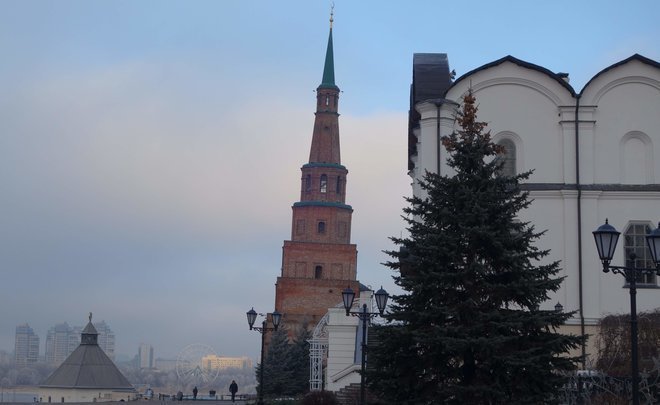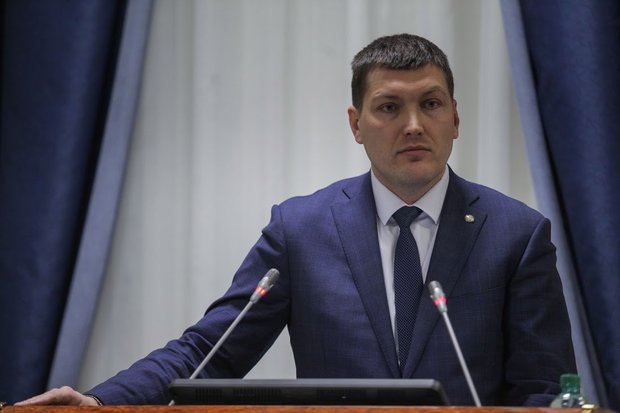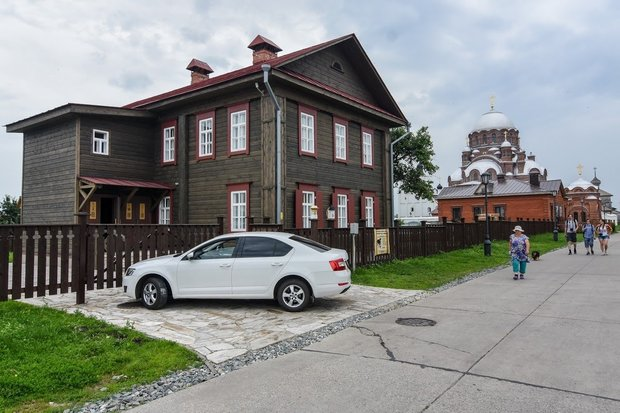Cultural Heritage Protection Committee to measure Syuyumbike Tower’s leaning angle with laser
The protection of the Kazan Kremlin is completely handed over to the republic

Due to the delegation of functions of protecting the territory of UNESCO World Heritage site — the Kazan Kremlin — to the republic by the federal centre, now the Tatarstan Cultural Heritage Protection Committee will take care of the state of the falling tower. Now its tilt is critical 2 metres. Read in Realnoe Vremya’s report what architectural landmarks will be restored this year, where all the information about historic buildings will appear, what historical settlements were criticised by Vice Premier Leyla Fazleyeva, why houses in Chistopol will be sold for one ruble, when a wooden church and mosque taken away from a Vologda master will be restored.
In memory of Lenin
A session of the Tatarstan Cultural Heritage Protection Committee opened a series of reports of republican agencies in the new year. The COVID-19 epidemic made its amendments: most participants in the meeting listened to it online. There was even shot and shown a separate film in memory of the contribution of deceased His Grace Feofan to the revival of religious holy sites in addition to a video report, which became traditional in such events.
In his report, head of the Cultural Heritage Protection Committee Ivan Gushchin dwelled on seven key parts: the sites whose restoration will end in 2021, the registry and issue of passports of historic landmarks, UNESCO World Heritage sites, urban engineering, historic settlements, cultural sites, supervisory activity.
So, restoration of the following sites will end in 2021:
- Muhammadia madrasah that will regain its historical purpose and where education will be organised;
- the administration building of Bolgarian Islamic Academy;
- the Love Arch in Black Lake, which is in an emergency state;
- two Lenin landmarks: a monument to Lenin in Freedom Square in Kazan and the proletariat leader’s museum house in Lenino-Kokushkino (Pestrechi District).
“The removal of the sculpture from its site caused a great public outcry, at the same time, it was a forced measure. The monument weighing tonnes remained in the square, it was cleaned with special solutions, while all parts and tiles of natural quartzite were labelled and sent to a stone processing factory to Kukmor,” Ivan Gushchin said.
The monument will be completely ready this spring. While a modern museum will appear in the refurbished house where the Ulyanovs lived.
Government Agency for people
Since the protection of the Kazan Kremlin was completely delegated to the republic (Russian Prime Minister Mikhail Mishustin approved a corresponding initiative of the Tatarstan administration last September), a complex of works is planned here. Particularly the functions of the building of the Government Agency will have to be finally determined soon.
Now monthly supervision of the leaning angle of the Syuyumbike Tower will fall on the committee’s shoulders. For this purpose, modern technology of terrestrial laser scanning will be used. Now the tilt of the tower is critical 2 metres. It is important to register the dynamics of its fall, which will be known in late 2021.
There is good news for another site that can be added to the World Heritage Site List. In December 2020, the Russian Ministry of Culture sent an application to the Centre for World Heritage to include a complex of astronomic observatories of Kazan Federal University to the preliminary list of sites of the Russian Federation that are candidates to join the World Heritage List.
Not only important to find but also include to the registry
Ivan Gushchin noted that the number of found cultural heritage sites increased compared to 2019 (15 sites). The not indifferent public plays a role here, he thanked it. It is important to not only find the landmarks but also include them to the United State Registry so that they are under real protection. The head of the committee noted that despite the difficult budget expenditure, there were done historical and cultural tests for 86 architectural landmarks. While the republic has 3,500 sites of this kind.
Due to a lack of financing, there are still problems with reaching target encumbrances to historical sites added to the United State Realty Registry. 625 cultural heritage sites including 213 archaeological sites need to be explored and have the borders of the territory approved.
Information about landmarks on geographical map
The chairman of the committee reminded the audience that strategically important documents regulating the activity in Kazan’s historical centre were approved in 2020. We’re talking about a change of the current areas of protection of the ensemble of the Kazan Kremlin and cultural heritage sites located in the city. They total 571 sites.

“The new requirements for urban regulations fixed by the Russian Ministry of Culture and Cabinet of Ministers of the Republic of Tatarstan will favourably influence the investment climate of the historical centre. Duplications in regimes are excluded, the requirements contain detailed information about all possibilities and prohibitions of construction in every zone. The protection zones, construction and economic activity regulation zones, protected natural landscape zones — there were created over 100 zones of this kind,” Gushchin stressed.
According to him, the work on updating the map and borders of the buffer zone of the Kazan Kremlin will end this year.
Now one can learn all the information about historical landmarks on the geographical map of the Republic of Tatarstan. It is an open system all people can use.
Construction without agreement
The issue of the construction that’s underway on the territory of historical settlements is the only critical point in Ivan Gushchin’s report. They amount to 13 in the republic, and when granting permits for construction, it is necessary to send a project’s documentation to the committee for consideration. However, municipalities disregard this responsibility. Gushchin complained that there were granted around 170 reports and notifications in Kazan, Chistopol, Yelabuga, Sviyazhsk and Mamadysh.
“There is a question, isn’t there any construction underway on other historical territories? Or there is by violating legislation. Such conclusions suggest themselves because we don’t receive appeals from other territories,” he claimed.

Houses in Chistopol to be privatised for 1 ruble
The toughest situation with heritage among all historical cities unfolds in Chistopol. Integrated inventory of the whole historical centre of the city was carried out last year. 190 sites in total were found, including 127 landmarks were included to the registry, and 63 buildings have a status as founded. Some of them in an unsatisfactory state.
Only 19 sites from the total number of landmarks are in the programme implemented by the Ministry of Culture of the Russian Federation with BRICS Development Bank. Complete restoration is planned in 12 of them, the facade, roof and the foundation will be repaired in seven.
Nowadays there was signed a public design contract. The first meeting with representatives of the Fund for Investment Construction Projects and designers took place in Kazan on 12 January. A road map was outlined.
The other 30 buildings in Chistopol, which are cultural heritage sites, will be privatised with a commitment to restore them. And probably for one ruble. The sites will begin to be prepared to be sold to investors this year already. Such a successful experience is available in Kukmor where an investor was sold a unique 19th-century mansion of Komarov factory owner — three buildings with a total area of 666 square metres.
Withdrawn wooden mosque and church to be restored
Gushchin stated that 411 cathedrals were under public protection at the moment — it is mosques and churches. He also remembered a sad experience of the invitation of Vologda restorer Aleksandr Popov to restore key cultural sites. The holy objects were restored in Kirillov for more than a year. Due to disagreement on cost, deadlines and the quality of works, the Cultural Protection Committee terminated the agreement. The wooden church and mosque were brought to the republic.
“Nowadays emergency prevention works are done by a Kazan licenser with specialists from Kostroma. It is weekly controlled by the committee. Unfortunately, the deadlines of the sites significantly shifted. At the same time, the promises given to residents of Bolshaya Yelga and Arkhangelsk Klyari will be kept — the sites will be restored and adjusted for religious purposes in 2021,” Gushchin promised.
The recreated Kazan Virgin Mary men’s monastery was mentioned as an example of successful restoration of cult buildings. Works in the upper part still go on, while services are already held in the cave church after consecration by Metropolitan of Kazan and Tatarstan Feofan.
The head of the Cultural Protection Committee noted the active participation of the deceased archbishop, including in the conservation of the oldest military memorial Monument to Dead Soldiers in the Kazanka River for whose financing an application was submitted in the federal centre.
Negligent owners are fined a million rubles
Last year, negligent owners of historical buildings were fined nearly a million rubles. There were found 86 violations of the legislation on protection of historical and architectural landmarks, natural persons and legal entities were drawn up 48 reports on misdemeanours. The speaker named the prevention of the demolition of a 19th-century mansion on Podluzhnaya Street owned by famous entrepreneur Ravil Ziganshin’s close relatives an outrageous fact. According to Gushchin, the committee still doesn’t know the intentions of the family regarding the monument.
But he noted that additional leverage for such owners of historical buildings would soon appear in the republic. The committee and the Ministry of Land and Property of the republic created an order of public tenders to sell cultural heritage objects that were withdrawn by the court’s decision and submitted it to the Tatarstan Cabinet of Ministers for approval. The document is expected to be adopted in the first quarter of the year.
Shortage of volunteers and specialists in heritage
Vice chairman and head of the Department of Public Cultural Heritage Protection of the Russian Ministry of Culture Nikolay Nikiforov supported his regional colleague and noted that changes in the legislation on privatisation of cultural heritage sites were prepared at federal level. In particular, it is planned to hold tenders instead of competition when selling historical buildings, which is to simplify their acquisition by investors. The Moscow guest also noted the big trust of Russia’s Culture Ministry in the republic’s management by delegating the protection of the Kazan Kremlin to it and planning a UNESCO World Heritage session in Tatarstan in 2022. “I am sure that the Kremlin will be protected well,” Nikiforov emphasised.
Vice Premier Leyla Fazleyeva noted that a lot of tasks and sites that had been biding them time were performed in 2020. “It is amazing gifts that influence the positive agenda,” she concluded and meant the negative COVID-19-related information background that prevailed last year.
She backed the chairman of the committee when he criticised the municipalities:
“I would ask all the colleagues representing the work in historical settlements in the republic to inventory what you did in 2020 and tell us about what tasks you set for yourself in 2021 and send this report to the apparatus of the Tatarstan government, and then we will hand over these documents to the president’s apparatus because you and we have a direct instruction of the president to develop and solve the problem of historical settlements. Colleagues note what historical settlements develop more or less well, at the same time, there are questions for Bugulma, Bolgar, Bilyarsk, Menzelinsk and Mendeleyevsk Districts.”

Fazleyeva stressed the importance of digitalisation vice head of Kazan’s Executive Committee Radik Shafigullin mentioned in his report. He presented a project of introduction of a geographical and information system, in fact, “a digital twin of Kazan”. Together with the geographical map, these systems must be very popular, Fazleyeva assumes.
The vice premier named another two “parts falling behind” — it is the training of specialists in historical heritage protection and development of volunteers’ movement. She asked to pay careful attention to these issues in 2021.